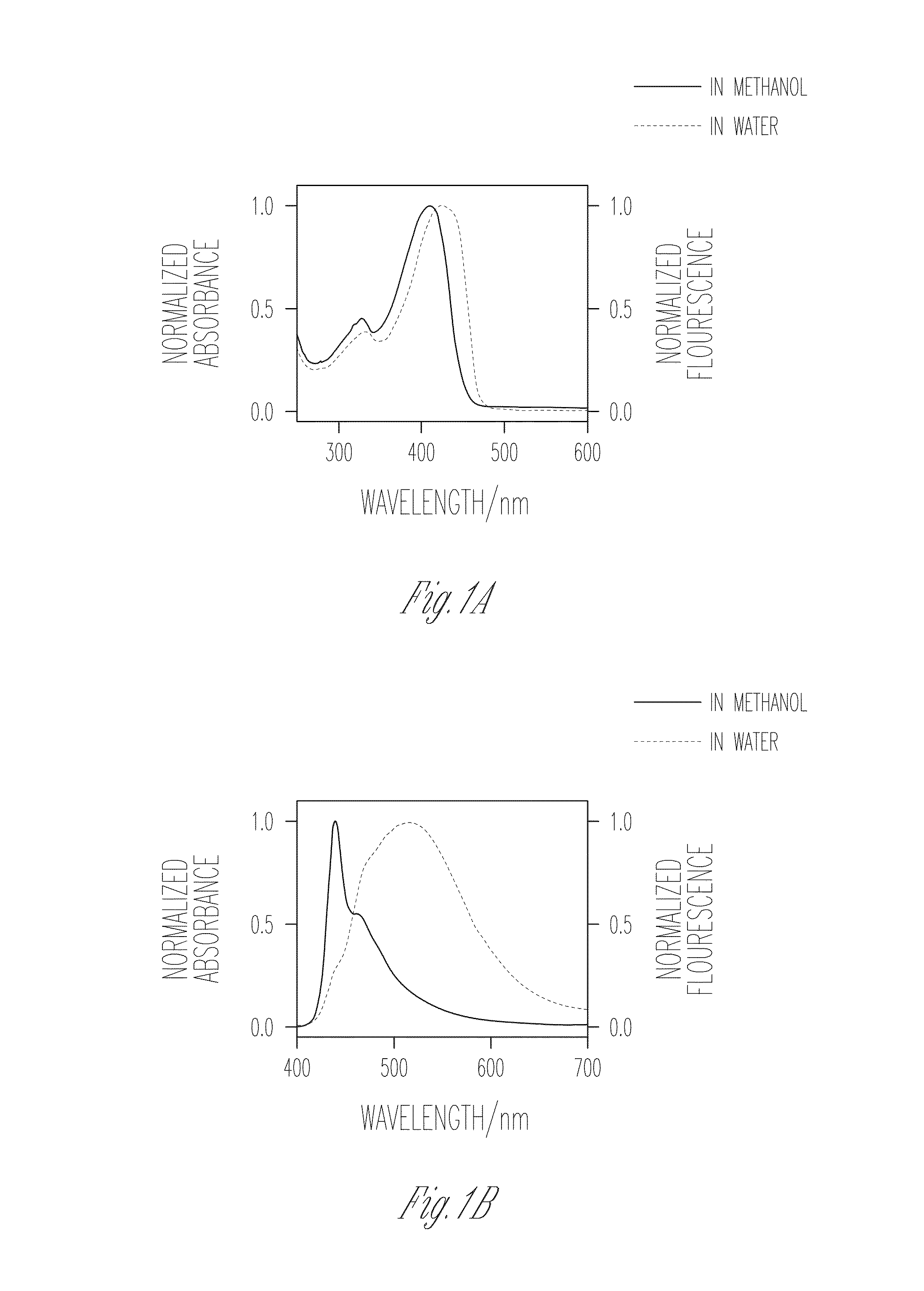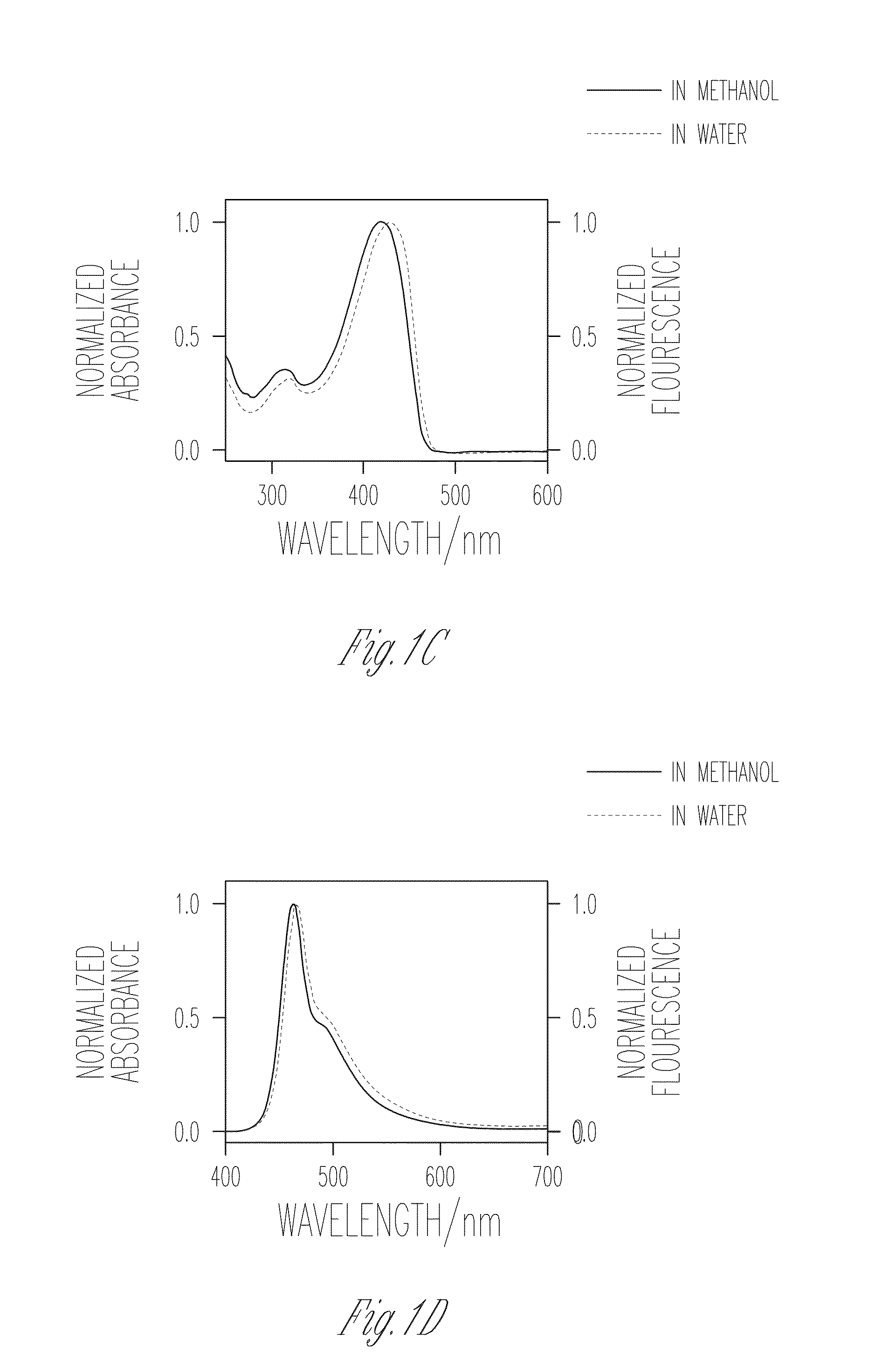Conjugated polyelectrolytes and methods of using the same
a technology of conjugated polyelectrolyte and polyelectrolyte, which is applied in the direction of biocide, bandages, conductors, etc., can solve the problems of reducing the propensity of cpe chains to interact with bacterial membranes, aggregation of cpe chains,
- Summary
- Abstract
- Description
- Claims
- Application Information
AI Technical Summary
Benefits of technology
Problems solved by technology
Method used
Image
Examples
example 1.1
Example 1.1.1
Synthesis of PIM-2 and PIM-4
[0095]Instrumentation and Methods. NMR spectra were recorded using a Varian VXR-300 FT-NMR, operating at 300 MHz for 1H NMR and at 75.4 MHz for 13C NMR. UV-visible absorption spectra were recorded using a Varian Cary 100 dual beam spectrophotometer with a scan rate of 300 nm / min.
[0096]The conjugated polyelectrolytes PIM-2 and PIM-4 were prepared.
[0097]PIM-2 and PIM-4 were prepared according to Scheme 1.
[0098]Triethylamine and tetrahydrofuran (THF) were purified by distillation over sodium hydride. Pd(PPh3)4 catalyst was used as received from Stream Chemical Co. Monomers. Compounds 1, 2, 3, 5, and 6 were synthesized following revised procedures reported in the literature. See McQuade, D. T.; Hegedus, A. H.; Swager, T. M. J. Am. Chem. Soc. 2000, 122, 12389; see also Ji, E.-K.; Whitten, D. G.; Schanze. K. S. Langmuir 2011, 27, 1565. Polymerization was performed under Sonogashira cinditions as described herein in Scheme 1.
[0099]Representative pol...
example 1.1.2
Absorption and Fluorescence
[0106]FIGS. 1A-D illustrate the absorption spectra of PIM-2 and PIM-4 in methanol and water, in accordance with various embodiments of the present invention. In methanol, PIM-2 features a strong fluorescence and a well-defined 0-0 band with λmax=410 nm along with a well resolved vibrational progression at lower energy that is characteristic of the PPE backbone. This observation indicates that PIM-2 exists in a mostly unaggregated state in methanol. By contrast, when water is used as the medium, PIM-2 exhibits a broad, structureless and red shifted emission. The red shift observed in both absorption and emission spectral bands, along with diminished fluorescence quantum yield in water together indicate the formation of aggregates in aqueous medium. On the contrary, comparison of the absorption and fluorescence spectra of PIM-4 in methanol and in water shows an interesting trend. In methanol, the 0-0 band with λmax=418 nm is observed to be slightly red shift...
example 1.1.3
Biocidal Testing
[0115]Biocidal testing was carried out using flow cytometry, confocal fluorescence microscopy, and standard plating techniques. The biocidal activity of both PIM-2 and PIM-4 is high in the presence of blue-violet light (λ=420 nm). FIG. 5 and FIG. 6 illustrate the biocidal activity of PIM-2 and PIM-4, respectively, against Gram-negativeE. coli. In FIG. 5 and FIG. 6. NC refers to the negative control, which did not contain biocidal polymer and red indicates % dead and green indicates % alive, as assessed by flow cytometry. At a concentration of just 5 μg / mL, PIM-2 is able to kill approximately 90% of E. coli in the presence of near-visible light. In the dark, however, a higher concentration of 20 μg / mL is required to exceed 90% killing. PIM-4 was found to induce 2-log killing of the E. coli in numerous samples, and even exceeding 3-log killing at high concentrations in the light.
[0116]Comparison of the efficacy of the two polymers suggests PIM-4 can have better light-a...
PUM
| Property | Measurement | Unit |
|---|---|---|
| concentration | aaaaa | aaaaa |
| concentration | aaaaa | aaaaa |
| concentration | aaaaa | aaaaa |
Abstract
Description
Claims
Application Information
 Login to View More
Login to View More - R&D
- Intellectual Property
- Life Sciences
- Materials
- Tech Scout
- Unparalleled Data Quality
- Higher Quality Content
- 60% Fewer Hallucinations
Browse by: Latest US Patents, China's latest patents, Technical Efficacy Thesaurus, Application Domain, Technology Topic, Popular Technical Reports.
© 2025 PatSnap. All rights reserved.Legal|Privacy policy|Modern Slavery Act Transparency Statement|Sitemap|About US| Contact US: help@patsnap.com



